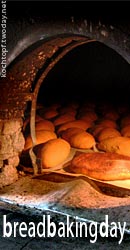
Ya he hablado con más de uno/a de cuánto me llama la atención que haya tanta variedad de productos (frutas, verduras, especias, también cocinas y culturas culinarias en general) todos juntos en un territorio "tan pequeño".
Supongo que no es tan sorprendente si pensamos que solo en el estado de Victoria se encuentra presencia de 248 paises, 289 idiomas diferentes y 128 religiones diferentes. Ésto es multiculturalidad y lo demás son tonterias.
Pues como los australianos no son tontos, les gusta probar todas las comidas de las culturas que los forman, y eso se traduce en un montón de programas de cocina en la tele, de revistas, libros, librerias especializadas en libros de cocina, y por supuesto en restaurantes de todo tipo.
La menda se está mirando últimamente programas de cocina en la tele, y libros (que son muy bonitos, con unas fotos impresionantes). Y resulta que hay ingredientes que no aparecen en ningún diccionario inglés-castellano (algunas palabras son slang, como el pollo, que le dicen chook en vez de chicken, otras no sé si existen). Y así voy a parar al debate sobre el
verjuice. (Mi santo me viene diciendo últimamente: "hace tiempo que no te enrrollas tanto en el blog, ¿te encuentras bien churra?, ya veis, todo en orden...)
Pues según la wikipedia, el
Verjus (del francés verjus "zumo verde"), conocido en castellano como agraz, es un zumo ácido extraído de uva blanca o manzana. Pero sigo sin saber qué es, si sidra, o mosto, o qué. Así que he pensado que quizá Juana me puede iluminar. Lo más divertido es que la misma Wiki, en su definición versión inglés, nombra a la estrella de los fogones australiana, Maggie Beer, del libro de recetas de quien he sacado el dichoso nombre...
Verjuice
From Wikipedia, the free encyclopedia
Verjuice (from Middle French vertjus "green juice") is a very acidic juice made by pressing unripe grapes. Sometimes lemon or sorrel juice, herbs or spices are added to change the flavour. In the Middle Ages, it was widely used all over Western Europe as an ingredient in sauces, as a condiment, or to deglaze preparations.
It was once used in many contexts wh
ere modern cooks would use either wine or some variety of vinegar, but has become much less widely used as wines and variously flavoured vinegars became more accessible. Nonetheless, it is still used in a number of French dishes as well as recipes from other European and Middle Eastern cuisines, and can be purchased at some gourmet grocery stores. The South Australian cook Maggie Beer has popularised the use of verjuice in her cooking, and it is being used increasingly in South Australian restaurants.
Modern cooks most often use verjuice in salad dressings as the acidic ingredient, when wine is going to be served with the salad. This is because verjuice provides a comparable sour taste component, yet without "competing with" (altering the taste of) the wine the way vinegar or lemon juice would.
Verjus, called husroum (حصروم) in Arabic, is used e
xtensively in Syrian cuisine. In Syria, much of the production of husroum is still done over the course of several days by female members of land-owning clans -- even if many of them live in cities. The husroum produced during this time will be distributed to various households within the extended family and used throughout the year. The same is true for the production of olive oil and tomato paste.
Verjus, called ab-ghooreh in Persian, is used extensively in Northern Iranian and Azerbaijani cuisine.
La señora Beer. Muy gr aciosa ella.
Huey's Cooking Adventure's. Yo le llamo "el de los tirantes". Éste me hace mucha gracia, cocina a lo bruto, echando las cosas a puñados en el puchero... me h ace sentirme más segura cuando agarro la sartén.


















































